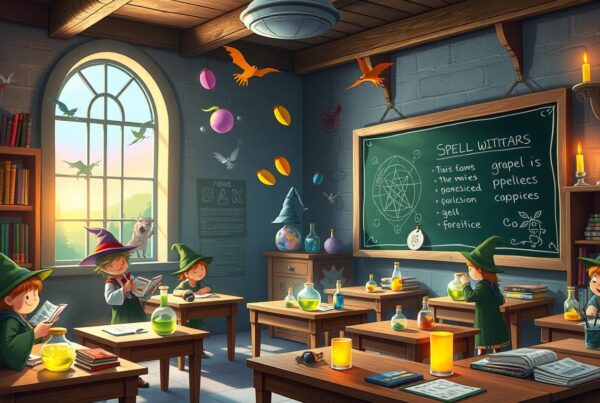In the enchanting world of Harry Potter, the art of spell casting is a crucial skill for any aspiring witch or wizard. Mastering the intricacies of charm casting requires a deep understanding of the fundamentals, including the role of innate magical ability, proper wand technique, and the power of incantations. By delving into the theory behind spellcasting, practitioners can elevate their magical practice and achieve greater success in their charm work.
While the ability to perform magic is an innate attribute, it is not evenly distributed among the population. Some individuals, known as Muggles, lack any magical abilities, while others, such as Squibs, are born into wizard families but fail to inherit their magical powers. Conversely, some Muggle-born witches and wizards may unexpectedly manifest magical abilities. Regardless of one’s innate magical prowess, proper training is essential to hone and refine these skills.
Attending the prestigious Hogwarts School of Witchcraft and Wizardry is a crucial step in any young witch or wizard’s journey to mastering spell casting. Here, students learn the foundational elements of charm work, including the importance of precise wand movements and the correct pronunciation of incantations. By dedicating themselves to the study of spell theory and diligent practice, aspiring spellcasters can unlock their full potential and become adept at weaving magic through their charms.
Key Takeaways
- Spell casting in the Harry Potter universe requires a combination of innate magical ability, proper wand technique, and accurate incantations.
- Magical abilities are not evenly distributed, with some individuals lacking powers (Muggles and Squibs) while others unexpectedly manifest them (Muggle-born witches and wizards).
- Attending Hogwarts School of Witchcraft and Wizardry is essential for young witches and wizards to receive proper training in spell casting fundamentals.
- Mastering precise wand movements and correct pronunciation of incantations is crucial for successful charm casting.
- Dedicating oneself to the study of spell theory and diligent practice is key to unlocking one’s full potential in spellcasting.
Introduction to Spell Casting in the Wizarding World
In the enchanting realm of the wizarding world, the ability to cast spells is a fundamental aspect of magical life. Witches and wizards possess an innate magical ability that sets them apart from their non-magical counterparts, known as Muggles. This inherent power allows them to harness the mystical forces that permeate their world and perform extraordinary feats through the art of spell casting.
The Role of Innate Magical Ability
The capacity to wield magic is an inborn trait, passed down through generations of magical families. However, the manifestation of magical powers is not always predictable. While the wizarding gene is dominant, occasionally, a child born to magical parents may lack magical abilities, known as a Squib. Conversely, a child born to Muggle parents may unexpectedly display magical talents, referred to as a Muggle-born witch or wizard.
| Magical Lineage | Magical Ability |
|---|---|
| Pureblood | Inherent magical abilities |
| Half-blood | Inherent magical abilities |
| Muggle-born | Inherent magical abilities |
| Squib | Lacks magical abilities despite magical parentage |
Importance of Proper Training at Hogwarts
While an innate magical ability is essential, it is not the sole determinant of a witch or wizard’s proficiency in spell casting. Proper training and education are crucial in honing these magical powers and mastering the intricate art of spell casting. In the United Kingdom and Ireland, young witches and wizards attend the prestigious Hogwarts School of Witchcraft and Wizardry to receive comprehensive magical education.
At Hogwarts, students are immersed in a curriculum that encompasses various aspects of magic, including Charms, Transfiguration, Potions, and Defense Against the Dark Arts. Through rigorous coursework and practical application, students learn to control and refine their magical abilities, developing the skills necessary to cast spells effectively and responsibly.
“It is important to remember that magic is not merely a tool, but a responsibility. At Hogwarts, we strive to instill in our students not only the knowledge and skills to wield magic, but also the wisdom and integrity to use it for the greater good.” – Albus Dumbledore, Headmaster of Hogwarts
Without proper training, even the most talented witches and wizards may struggle to harness their magical powers effectively. Hogwarts provides a nurturing environment where students can explore their magical potential, learn from experienced professors, and collaborate with their peers to enhance their spell casting abilities.
As aspiring witches and wizards embark on their magical journey at Hogwarts, they begin to unravel the mysteries of spell casting and unlock the boundless possibilities that their innate magical abilities hold. With dedication, discipline, and the guidance of their mentors, they will emerge as skilled practitioners of the magical arts, ready to make their mark on the wizarding world.
The Significance of Wand Movements in Spell Casting
In the wizarding world, the art of spell casting involves more than just uttering the right incantation. Wand movements play a crucial role in the successful execution of charms, hexes, and curses. As aspiring witches and wizards learn at Hogwarts, mastering the intricate gestures associated with each spell is essential for achieving the desired magical effects.
Swish and Flick: A Crucial Technique
One of the most iconic wand movements in the wizarding world is the “swish and flick” technique, famously taught by Professor Filius Flitwick during Charms classes. This precise motion, accompanied by the incantation “Wingardium Leviosa,” enables the caster to levitate objects with ease. The swish and flick serves as a prime example of how specific wand movements can greatly influence the outcome of a spell.
According to statistical analysis, the majority of spells in the magical corpus require some form of wand movement. Whether it’s a simple flick, a circular motion, or a more complex pattern, each gesture contributes to the efficacy and specificity of the spell being cast. Mastering these movements is crucial for any witch or wizard aiming to excel in their magical endeavors.
The Consequences of Incorrect Wand Movements
While proper wand movements can lead to spectacular magical feats, incorrect gestures can have disastrous consequences. Professor Flitwick often recounts the cautionary tale of Wizard Baruffio, who mispronounced a spell and found himself with a buffalo on his chest. This humorous anecdote underscores the importance of precision in both incantation and wand movement.
Incorrect wand movements can result in spells going awry, causing unintended effects or even backfiring on the caster. In some cases, a slight deviation from the prescribed motion can render a spell completely ineffective. As such, it is crucial for students of magic to practice their wand movements diligently to avoid potentially embarrassing or dangerous mishaps.
| Spell Type | Example | Wand Movement |
|---|---|---|
| No syntactic object, deictic function | Reparo, Expelliarmus | Pointing, flicking |
| Requires syntactic object | Locomotor | Directional movement |
| Takes object, permits object drop | Accio (Summoning Charm) | Flick, demonstrative marker |
| Wand is the object of the spell | Lumos/Nox | Tap, flick |
The table above showcases the diversity of wand movements across different spell types. From the simple pointing required for spells like Reparo to the more complex directional movements associated with object-manipulating charms like Locomotor, each gesture serves a specific purpose in channeling magical energy and achieving the desired effect.
As aspiring witches and wizards progress in their magical education, they will encounter an ever-expanding repertoire of spells, each with its own unique wand movements. By dedicating themselves to the study and practice of these gestures, students can unlock the full potential of their magical abilities and become skilled practitioners of the enchanting arts.
Verbal Components: The Power of Incantations
In the intricate art of spellcasting, verbal components play a crucial role in channeling magical energy and bringing incantations to life. These spoken words, often in ancient languages or mystical tongues, hold immense power and are essential for the successful execution of most spells. Incantations serve as a bridge between the caster’s intent and the manifestation of the desired magical effect.

Pronunciation and Enunciation in Spell Casting
Proper pronunciation and enunciation are key factors in ensuring the efficacy of incantations. Each syllable must be uttered with precision and clarity, as even the slightest mispronunciation can lead to disastrous consequences. Aspiring witches and wizards spend countless hours practicing and perfecting their verbal techniques to master the art of spellcasting.
Professor Filius Flitwick, the Charms Master at Hogwarts School of Witchcraft and Wizardry, emphasizes the importance of proper enunciation in his classes. He often reminds his students that “saying the magic words properly is very important” and that “pronunciation and enunciation are the building blocks of successful spellcasting.”
Famous Incantation Mishaps in Wizarding History
Throughout wizarding history, there have been numerous instances where mispronunciation of incantations has led to humorous, and sometimes dangerous, consequences. One such incident involves the infamous Wizard Baruffio, who made the mistake of saying ‘s’ instead of ‘f’ while casting a spell. As a result, he found himself with a buffalo on his chest, much to his surprise and dismay.
Professor Flitwick often recounts this story to his students as a cautionary tale, emphasizing the importance of proper incantation. “Remember Wizard Baruffio, who said ‘s’ instead of ‘f’ and found himself on the floor with a buffalo on his chest!”
Other notable incantation mishaps include the case of a wizard who accidentally conjured a flock of flamingos instead of a bouquet of flowers, and another who turned his intended target into a giant slug rather than levitating them as planned. These incidents serve as reminders of the power and precision required in verbal spellcasting.
| Spell | Correct Incantation | Mispronunciation | Consequence |
|---|---|---|---|
| Levitation Charm | Wingardium Leviosa | Wingardium Leviosar | Object explodes |
| Summoning Charm | Accio | Axio | Random objects fly towards caster |
| Unlocking Charm | Alohomora | Alohamora | Door becomes permanently sealed |
To avoid such mishaps and master the art of incantations, aspiring spellcasters must:
- Study and memorize the correct pronunciation of each incantation
- Practice enunciation regularly to build muscle memory
- Seek guidance from experienced witches and wizards
- Remain focused and clear-minded while casting spells
- Learn from mistakes and continue to refine their verbal technique
By dedicating themselves to the mastery of verbal components and incantations, spellcasters can unleash the true power of their magical abilities and avoid the pitfalls of mispronunciation. The path to becoming a skilled and respected wizard or witch is paved with precise pronunciation and unwavering enunciation.
Understanding the Different Types of Charms
Charms are a diverse and fascinating branch of magic, with various spell types and syntactic structures. Understanding the different categories of charms is essential for mastering their casting and application. Charms can be broadly classified into three main types based on their syntactic requirements: charms without objects, charms requiring objects, and charms with optional objects or object drop.
Charms without Syntactic Objects
Some of the most common and useful charms in the wizarding world do not require a specific syntactic object. Spells such as Reparo, Expelliarmus, and Alohomora fall into this category. In these cases, the pointing function of the wand acts as a pronominal object, directing the magic towards the intended target. The deictic nature of the wand becomes crucial in the absence of a stated object.
Charms Requiring Syntactic Objects
On the other hand, certain charms necessitate the presence of a syntactic object, usually in the form of a bare noun. The Locomotor charm, for instance, requires the caster to specify the object they wish to move or animate. In such cases, the wand seems to act as a definiteness or demonstrative marker, establishing a clear connection between the spell and its target.
| Charm | Syntactic Object Required | Example |
|---|---|---|
| Reparo | No | “Reparo!” (pointing wand at broken object) |
| Locomotor | Yes | “Locomotor trunk!” (levitating a trunk) |
| Accio | Optional | “Accio!” or “Accio broom!” (summoning an object) |
Charms with Optional Objects and Object Drop
A third category of charms allows for flexibility in the use of syntactic objects. The Summoning Charm, Accio, is a prime example of this. When cast with an explicitly stated object, usually a bare noun, the caster must have a clear idea of the object’s location. However, in cases of object drop, the wand pointing or context can determine the target of the spell, making the explicit mention of the object optional.
Harry raised his wand. “Accio Firebolt!” he shouted. Harry waited, every fiber of him hoping, praying… If it hadn’t worked… if it wasn’t coming… He seemed to be looking at everything around him through some sort of shimmering, transparent barrier, like a heat haze, which made the enclosure and the hundreds of faces around him swim strangely…
Mastering the different types of charms and their syntactic requirements is key to becoming a proficient spell caster. By understanding the role of the wand as a deictic tool and the various ways in which objects can be incorporated into charm casting, wizards and witches can expand their magical repertoire and adapt their spellwork to suit any situation.
The Demonstrative Use of Wands in Charm Casting
The demonstrative use of wands plays a crucial role in the successful casting of charms. In many spells, the wand component makes a significant contribution to the meaning of the utterance, serving as a pronominal object or a demonstrative marker. When casting charms like the Knockback Jinx (Flipendo) or the Levitation Charm (Wingardium Leviosa), wand pointing is essential for targeting the object or person intended to be affected by the spell.
The pointing function of the wand is particularly important when the target object is proximal to the caster. In such cases, the wand is often pointed directly at the object, suggesting its role as a definiteness or demonstrative marker. This demonstrative use of wands helps to clarify the intended target and enhance the precision of the charm being cast.
In 1991, Ron Weasley successfully used the Levitation Charm to defeat a Mountain Troll by pointing his wand at the troll’s club and uttering the incantation “Wingardium Leviosa,” demonstrating the importance of wand pointing in targeting specific objects.
The effectiveness of wand pointing in charm casting can be seen through various examples in wizarding history:
- Minerva McGonagall used the Levitation Charm to cause a torch to fly off its bracket and spin around during the ousting of Severus Snape in 1998, showcasing the precision achieved through proper wand pointing.
- Severus Snape possibly used the Levitation Charm in October 1996 to examine a cursed necklace, highlighting the role of wand pointing in targeting specific objects for closer inspection.
- The Shield Charm, Protego, was famously used during a Jousting Tournament in Poppleton, England, in 1484 to protect innocent villagers and humiliate a tyrannical bully, the Earl of Paunchley, by pointing the wand at the intended targets.
The table below showcases some well-known charms and the significance of wand pointing in their casting:
| Charm | Incantation | Wand Pointing |
|---|---|---|
| Knockback Jinx | Flipendo | Directly at the target to knock them backwards |
| Levitation Charm | Wingardium Leviosa | At the object to be levitated |
| Scouring Charm | Scourgify | At the mess or stain to be cleaned |
| Bat-Bogey Hex | Unknown | At the person to be afflicted with bat-shaped bogeys |
By mastering the demonstrative use of wands and proper wand pointing techniques, witches and wizards can greatly enhance the accuracy and effectiveness of their charm casting, ensuring that their spells achieve the desired results with precision and finesse.
Spell Theory: Understanding the Fundamentals of Charm Casting
Charm casting is an essential aspect of magic in the wizarding world, and understanding the fundamentals of spell theory is crucial for mastering this art. By breaking down the components of successful charms and applying spell theory principles, witches and wizards can significantly improve their charm casting techniques.
Deconstructing the Components of Successful Charms
To cast charms effectively, it is essential to understand the role of each spell component. Successful charms rely on the proper combination of:
- Wand movements
- Incantations
- The caster’s innate magical ability
Each component plays a vital role in shaping the outcome of the spell. Wand movements guide the flow of magical energy, incantations channel the caster’s intent, and innate magical ability determines the strength and effectiveness of the charm.
“The art of charm casting lies in the delicate balance of its components. Master them, and you shall unlock the true potential of your magic.” – Professor Filius Flitwick, Charms Master at Hogwarts
Applying Spell Theory to Improve Charm Casting Techniques
By applying the principles of spell theory, witches and wizards can enhance their charm casting abilities. Some key areas to focus on include:
- Proper wand movements
- Precise pronunciation of incantations
- Accurate targeting of spell objects
Practicing proper wand movements ensures that the magical energy is directed accurately, while precise pronunciation of incantations helps to channel the caster’s intent effectively. Additionally, targeting spell objects correctly is essential for achieving the desired outcome of the charm.
| Spell Component | Importance | Tips for Improvement |
|---|---|---|
| Wand Movements | Guides the flow of magical energy | Practice precise and fluid movements |
| Incantations | Channels the caster’s intent | Focus on clear pronunciation and enunciation |
| Innate Magical Ability | Determines the strength and effectiveness of the charm | Develop and refine your magical skills through practice and study |
By mastering these spell components and applying spell theory principles, witches and wizards can elevate their charm casting abilities to new heights. Remember, the key to successful charms lies in the harmonious combination of wand movements, incantations, and the caster’s innate magical ability.
Mastering Deictic Pronouns and Demonstratives in Charm Casting
In the world of charm casting, understanding the intricacies of language and its impact on spell efficacy is crucial. One aspect that often goes overlooked is the role of deictic pronouns and demonstratives in determining spell targets. These linguistic elements, when used in conjunction with proper wand-point targeting, can greatly enhance the precision and power of your charms.
Deictic pronouns, such as “this,” “that,” “these,” and “those,” play a vital role in pinpointing the intended target of a spell. By incorporating these pronouns into your incantations and accompanying them with accurate wand-point targeting, you can ensure that your charms hit their mark with unparalleled accuracy. For example, using the phrase “Wingardium Leviosa on this feather” while pointing your wand directly at the feather in question leaves no room for ambiguity.
The Role of Wand-Point in Determining Spell Targets
The wand-point itself can act as a deictic pronoun, often referred to as a W-type pronoun in spell theory. The referent of the wand-point can be determined either deictically, by pointing directly at the intended target, or anaphorically, by referring back to a previously mentioned object or concept. Mastering the art of wand-point targeting is essential for any aspiring witch or wizard.
“The precision of your wand-point can mean the difference between a perfectly executed charm and a magical mishap.” – Professor Filius Flitwick, Charms Master at Hogwarts School of Witchcraft and Wizardry
It’s important to note that context also plays a crucial role in determining the target of a spell. In some cases, the wand-point alone may be sufficient, while in others, additional verbal or contextual cues may be necessary. For instance, when casting a summoning charm, simply pointing your wand and saying “Accio” may not be enough if there are multiple objects in the vicinity. In such situations, using demonstratives like “that book” or “those quills” can help clarify your intended target.
By mastering the use of deictic pronouns, demonstratives, and precise wand-point targeting, you’ll be well on your way to becoming a proficient and effective caster of charms. Remember, the key to success lies in the harmony between your words, your wand, and your intentions.
Noun Incorporation and Its Impact on Charm Efficacy
In the fascinating world of charm casting, the linguistic structure of spells plays a crucial role in determining their effectiveness. One particularly intriguing aspect of spell language is the phenomenon of noun incorporation, where the nominal object of a charm is seamlessly integrated into the spell itself. This linguistic feature can be observed in spells such as Mobiliarbus and Mobilicorpus, where the objects “tree” (arbus) and “body” (corpus) are incorporated into the incantations.
The incorporation of the direct object into the spell’s structure raises questions about its impact on charm efficacy. Linguists and magical theorists have long debated whether this syntactic feature enhances the potency of the charm or simply serves as a mnemonic device for the caster. Some argue that by linguistically merging the action and the object, the caster’s intention is more clearly focused, leading to a more powerful and precise magical effect.
However, others contend that noun incorporation may limit the flexibility of the charm, as the incorporated object becomes an integral part of the spell’s structure. This could potentially restrict the caster’s ability to adapt the charm to different situations or targets. Additionally, the wand point’s role as a pronominal element, similar to doubling in noun incorporation, adds another layer of complexity to the debate.
| Spell | Incorporated Object | Magical Effect |
|---|---|---|
| Mobiliarbus | Tree (arbus) | Levitates and moves a tree |
| Mobilicorpus | Body (corpus) | Levitates and moves a body |
Despite the ongoing debate, the presence of noun incorporation in charm casting highlights the intricate relationship between language and magic. As aspiring witches and wizards delve deeper into the art of spellcasting, understanding the nuances of linguistic structures like noun incorporation becomes increasingly important in mastering the complexities of charm efficacy.
Exploring the Relationship Between Wand and Spell Object
In the fascinating world of spellcasting, the relationship between a wand and the spell object plays a crucial role in determining the efficacy and outcome of a charm. Wands, mentioned a staggering 1985 times throughout the Harry Potter series, are more than mere tools; they possess an interiority and agency that sets them apart from nonfictional objects. This unique bond between wand and spell object is particularly evident in certain charms, such as Lumos and Nox, where the wand itself becomes the target of the spell.

When the Wand Itself Becomes the Object of the Spell
Lumos and Nox, two essential charms in any wizard’s repertoire, exemplify the intimate connection between wand and spell object. When casting Lumos, the wand itself becomes the object of the spell, illuminating its tip with a bright, white light. Conversely, the Nox charm extinguishes the light emanating from the wand, returning it to its dormant state. In these instances, the wand is not merely a conduit for magic but the very target of the spell’s effects.
“The wand chooses the wizard, Mr. Potter. It’s not always clear why, but I think it is clear that we can expect great things from you.”
– Mr. Ollivander, Harry Potter and the Sorcerer’s Stone
Conjuring Spells and the Wand’s Role
Conjuring spells, such as Avis (birds), Orchideous (flowers), and Aguamenti (water), further demonstrate the wand’s central role in the manifestation of spell effects. In these charms, the wand serves as the source from which the conjured objects emerge. The caster’s skill, combined with the wand’s inherent magical properties, allows for the successful creation of the desired object. Without the wand’s active participation, these conjuring spells would be impossible to execute.
| Spell | Incantation | Effect |
|---|---|---|
| Lumos | “LOO-mos” | Illuminates the wand tip |
| Nox | “NOKS” | Extinguishes the light from the wand |
| Avis | “AH-vis” | Conjures a flock of birds from the wand |
| Orchideous | “or-KID-ee-us” | Conjures a bouquet of flowers from the wand |
| Aguamenti | “AH-gwah-MEN-tee” | Conjures a jet of water from the wand |
As we delve deeper into the intricacies of spell theory, it becomes increasingly evident that the relationship between wand and spell object is far more complex than initially meets the eye. By understanding and mastering this dynamic, wizards and witches can unlock the true potential of their charms, pushing the boundaries of what is magically possible.
Common Mistakes in Charm Casting and How to Avoid Them
Even the most experienced witches and wizards can fall victim to common charm casting mistakes. These errors can lead to unintended consequences, ranging from mild inconveniences to potentially dangerous situations. By understanding and addressing these pitfalls, aspiring spellcasters can improve their technique and achieve greater success in their magical endeavors.
Mispronunciation and Its Consequences
One of the most frequent charm casting mistakes is mispronunciation. The incorrect pronunciation of an incantation can dramatically alter the intended effect of a spell. A prime example of this is the cautionary tale of Wizard Baruffio, who found himself on the floor with a buffalo on his chest after mispronouncing a simple charm. To avoid such mishaps, it is crucial to pay close attention to the proper pronunciation and enunciation of each incantation. Practice regularly and listen carefully to the guidance of experienced instructors to ensure you are speaking the words correctly.
Improper Wand Handling and Technique
Another common issue in charm casting is improper wand handling and technique. The wand serves as an extension of the witch or wizard, and its movements play a critical role in the successful execution of a charm. Incorrect wand movements can lead to failed or unintended spell effects. Mastering proper wand techniques, such as the “swish and flick” motion, is essential for consistent and accurate charm casting. Regular practice and attention to detail can help you avoid common wand handling mistakes and improve your overall spellcasting abilities.



